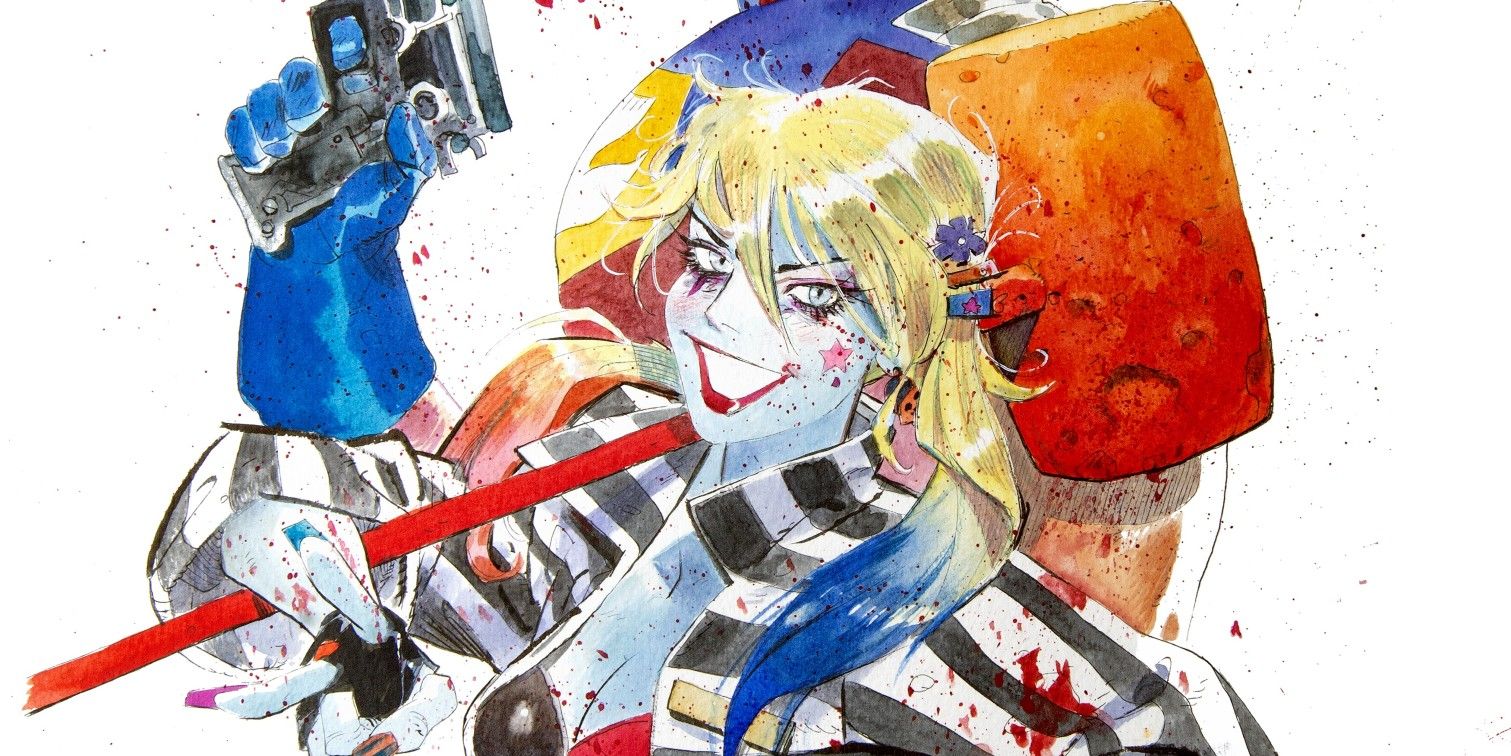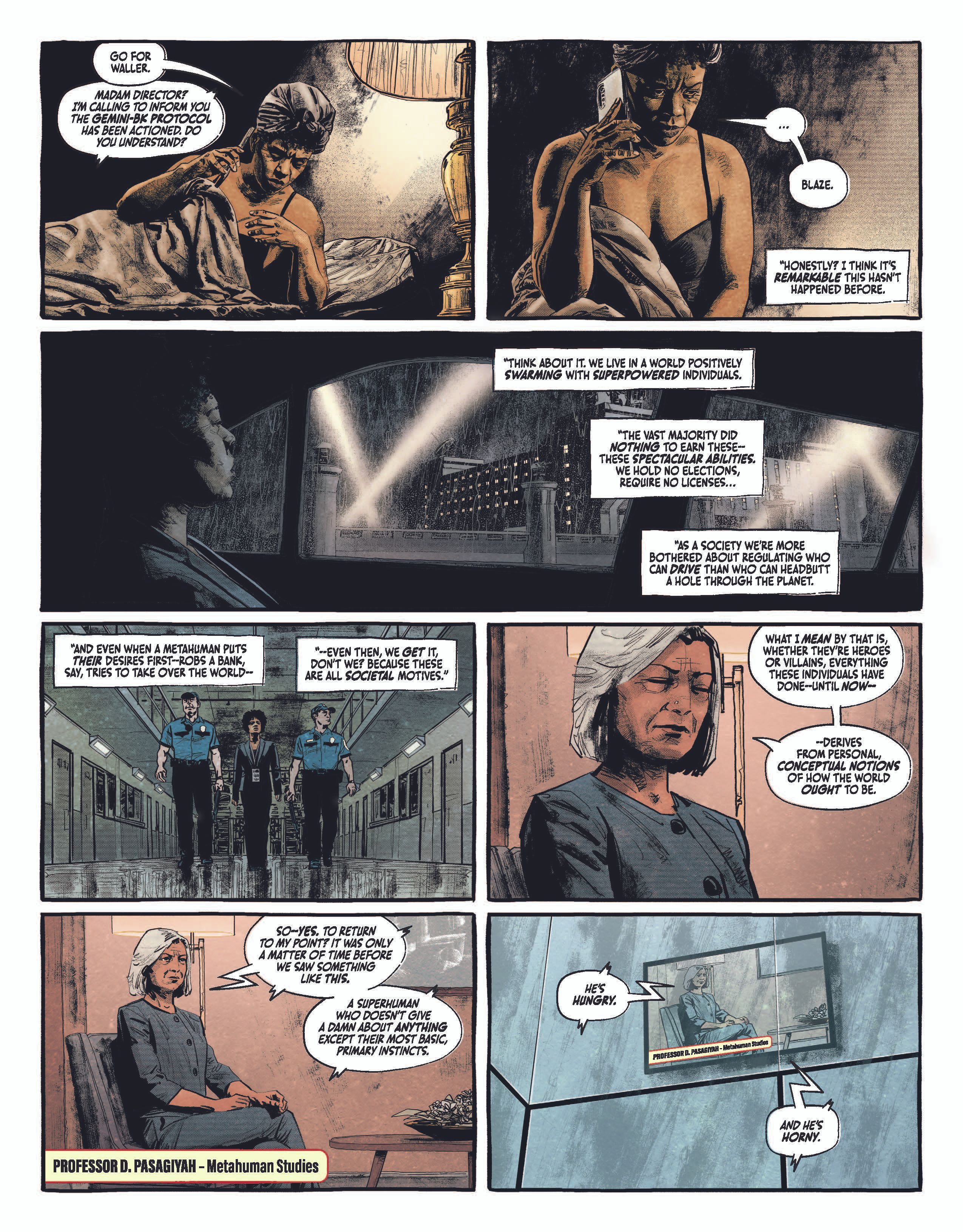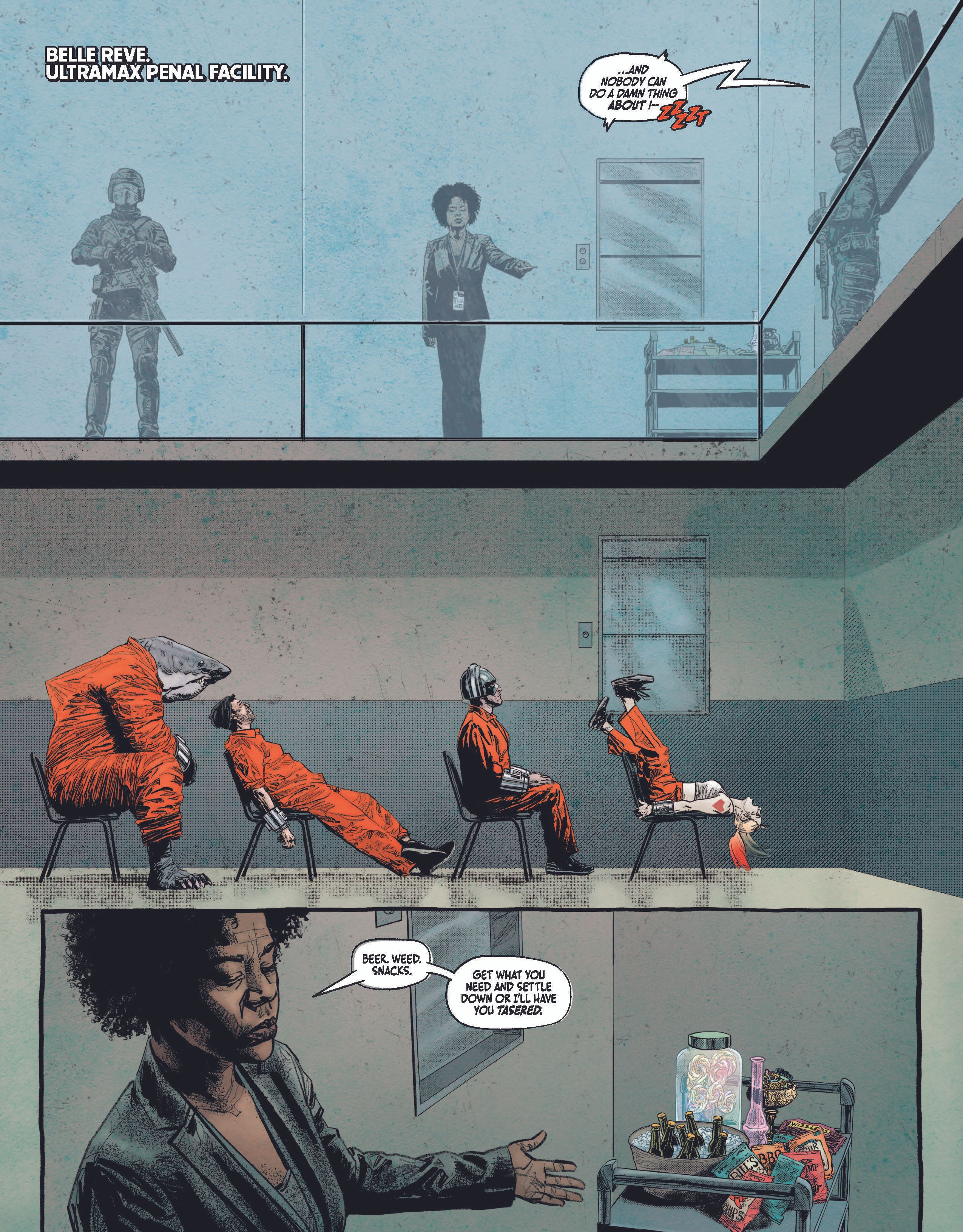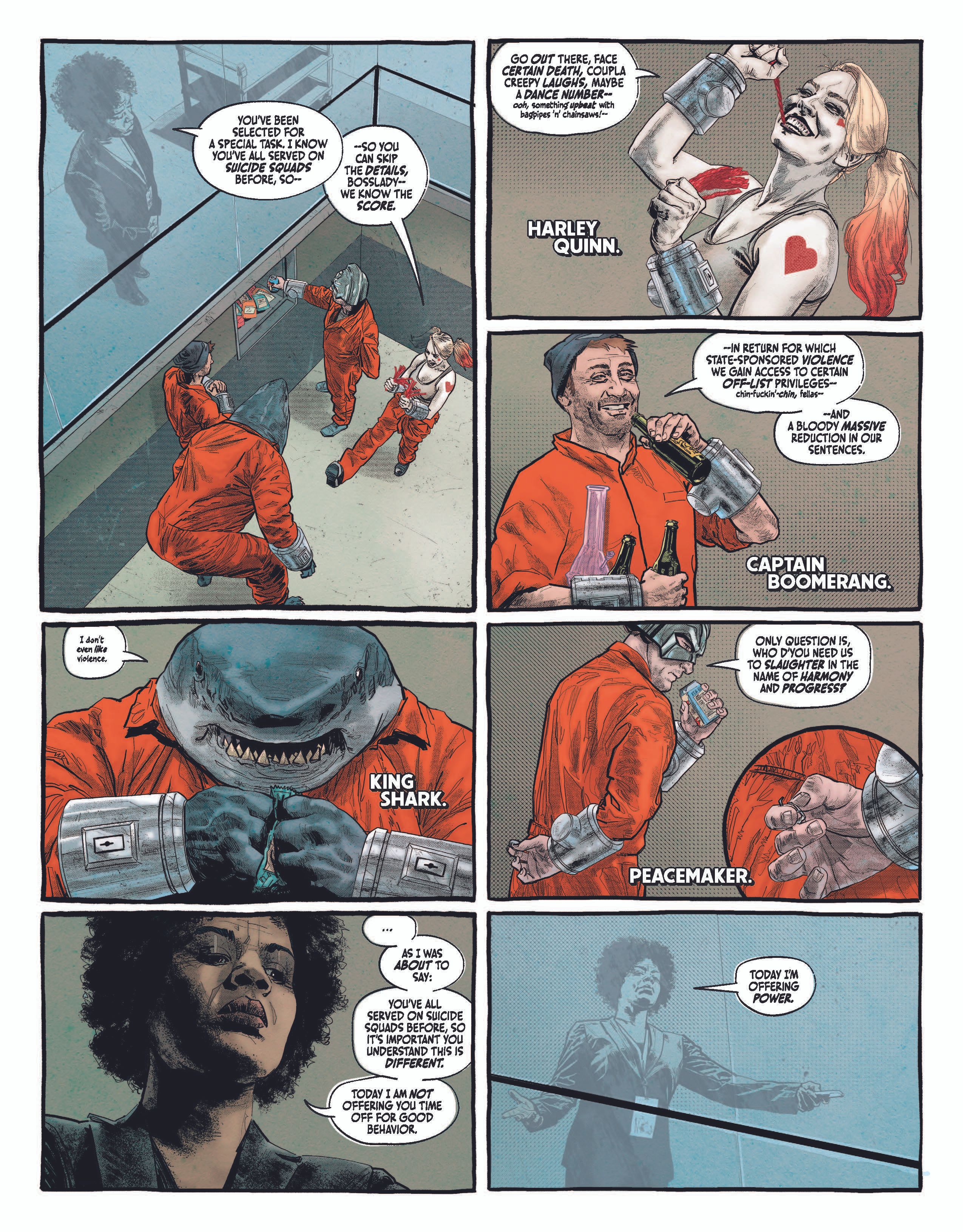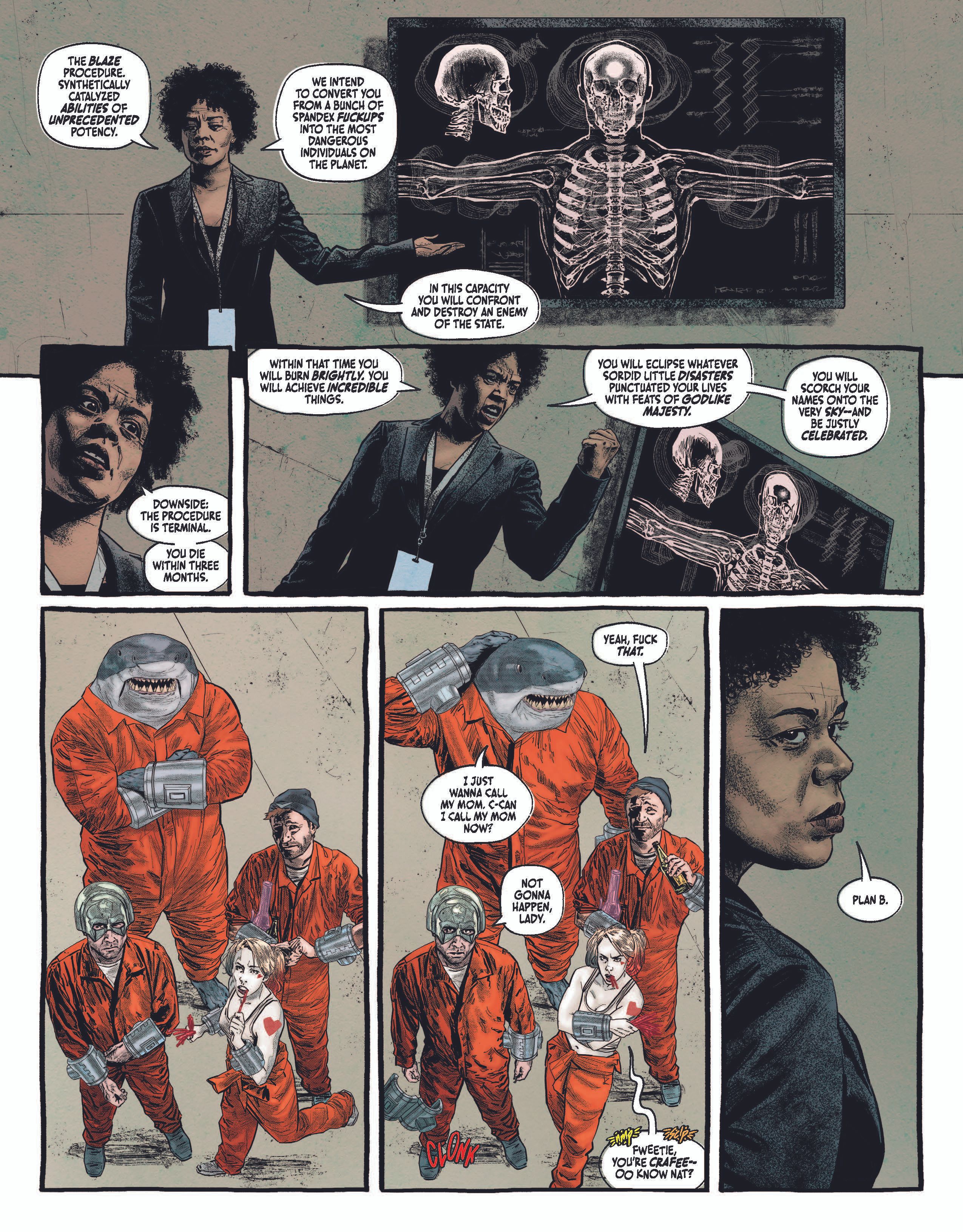WARNING: The following contains spoilers for Suicide Squad: Blaze #1, on sale now from DC Comics.
The latest DC Black Label miniseries Suicide Squad: Blaze follows a group of criminals who agree to take a serum that will artificially give them superpowers in exchange for shortening their lifespan to a matter of months. The classic Suicide Squad mentors this next generation of Amanda Waller's Task Force X. When a mysterious creature begins carving a bloody path of destruction around the globe, the crew must find a way to put a stop to the violence. Reuniting the acclaimed John Constantine: Hellblazer team of Simon Spurrier and Aaron Campbell, the miniseries is off to a thrilling start and already full of shocking twists and turns.
In an exclusive postgame interview with CBR, Spurrier and Campbell detail some of the major moments from Suicide Squad: Blaze #1, reflect on the creative challenges in bringing this ambitious story to life and tease what readers can expect next. Also included are preview pages from the debut issue, written by Spurrier, illustrated by Campbell, colored by Jordie Bellaire and lettered by Aditya Bidikar.
CBR: The centerpiece of Suicide Squad: Blaze #1 is this doozy of a prison brawl, with the classic Suicide Squad at the heart of it. How was it staging such an epic sequence?
Aaron Campbell: I work with models and shoot photo-reference for basically everything and, thankfully, one of my friends who helped me on this is an actual camera operator for film who has worked on some big stuff. He helped me a lot in conceiving how to set this up. I approached it from a filmmaking perspective where I really had to think about every beat and try to think about how the camera is moving around this space and avoid breaking the 180 barrier, which is you don't move at a 180-degree angle from your establishing shot of your characters otherwise your sense of relationship to your characters gets thrown off. The first time I heard about it, I was working with Andy Diggle who called it out and now it's the first thing I think about when I'm building a scene.
It took me a long time to get through choreographing that entire scene and what I started with was zooming in and focusing on who was most important in this shot and what was the action that was happening. There's a character named Javi who leaps past Peacemaker in that double-page spread to get into the free zone. It was about how do these two characters play with each other -- Javi is an exuberant character who is just canned heat and he's just going to bound and leap over everyone. I built the rest of the scene around those two, filling it in with the chaos of the moment.
With the big spreads, I'm always trying to figure out how to compartmentalize who's engaging with who and how they're overlapping with each other and go from there. There's a lot of chaos baked into it so I'm just trying to tease out the chaos and semblance of recognition of what's happening. It's the same thing as the creature, it's swirling chaos but, in all that chaos, you can see just enough to signify what you're looking at and give you a sense of familiarity.
Speaking of protagonist Michael van Zandt, he appears to be wrapped around Tanya's finger and willing to do anything for her while Tanya herself is a real queen mixer, goading Harley Quinn. What does she bring to the proceedings?
Simon Spurrier: You're not wrong. She comes across as someone who would have people wrapped around her finger but one of the things we'll slowly realize is that this isn't the behavior of a manipulator. She's not consciously somebody who makes people do her bidding. She's like that song "Ruby Tuesday," somebody who just fills the people around them with inspiration and wonder because everything she does is just a bit interesting. Clearly she and Michael have this history of extraordinary passion that has become heightened in Mike's mind and mythologized as this totally reciprocal love.
The moment he realizes that she hasn't spent their whole time apart obsessed with him and dreaming of him, it's just crushing for someone as dependent as he is. She is not a dependent person. She's someone who just marches to her own tune and does so uncynically and people just tend to join in and dance with her. That's a gift or a horror, depending on who you are. What's fascinating is, over the course of the subsequent issues when she achieves this near-limitless power as a result of the Blaze procedure, it starts to change her in interesting ways.
What starts as a mono-directional for Mike towards Tanya has quite a few twists and turns to take over the course of the whole story as a result of the newfound power that they each have and looming certainty of mortality as it creeps towards them. When you start out with a character who seems to be one thing, anything sci-fi or supernatural to confront them and make them change their lives is pure story gold.
Aaron, I have to ask: Did you draw yourself into this issue?
Campbell: Yeah, I'm Boris. [laughs] Si is actually the one who suggested it and felt I would be perfect for it.
Spurrier: He was so grumpy when he read the end of Issue #1. [laughs]
You've also got the Justice League as we've never seen them before, mired in their own bureaucracy in these news broadcasts. How was it putting this twist on these established heroes?
Spurrier: In as much as this story is interested in the dregs of superhuman community, not just the Suicide Squad but also these new, doomed members of the superhuman fraternity, the A-listers of the type take the role of distant, preening, outward-obsessed icons of what it means to be representative of truth, justice and the American Way. There's a whole conversation in the middle of the issue in which we interrogate why Mike is such a bummer towards superhumans and someone much lovelier than who Mike is gets to present the reality and realpolitik of what superhumans mean towards a nation, the world or the moral compasses of ordinary people.
We're going to see more of the Justice League, not just as Greek chorus characters who are popping up on TV screens, but increasingly players in this drama. Not to dive into spoilers but if the world is being tormented by a flying, cannibalistic, rage-fueled, overly-horny superhuman, then somebody is going to ask Superman where he was last night. [laughs] He's got a good answer, that's not where this is going, but it's that creeping moment when people start to get scared of something and they start to question the things they're already familiar with. They thought these things could be comforting but it turns out they're actually quite frightening and that's something I'm fascinated by.
Campbell: For me, I think if we live in a world where superhumans actually exist, we street-level people would all be suffering from PTSD. We'd live in a world of utter, absolute turmoil where every moment of everyday is a complete uncertainty. We'd always be looking over our shoulders and afraid of what might pop up and that fits right into my doom-and-gloom aesthetic and I love exploring those ideas.
Spurrier: There's a pundit who pops up in the middle of the issue on a TV show who says, "We live in a world where we're more interested in making sure people have licenses for driving cars than we are making sure they have a license to be able to head butt a hole through our planet." [laughs] There are some pretty clear metaphors here with weapons control and law enforcement which we're not going to be too overt about but it's there if you want to find it.
How has it been writing for the prestige format, getting the pacing down with such an increased page count per issue?
Spurrier: In a Hellblazer story or any other horror story, there are recognized conventions towards pacing. You want to play out the tension as long as you can and deliver a few small shocks and moments of adrenaline. You want to leave the big stuff as late as you can because there's nothing more disappointing in a monster movie than when you get to see the monster. The reality of the comic book format, especially a spandex comic, is that people are going to be expecting fights and moments of heavy drama. We had to find this cute, hybrid model.
This is a pretentious reference but Sergio Leone talks about Once Upon a Time in the West as being deliberately paced like the ragged, dying gasps of a man who's been gutshot in that it starts out really slow and there's an explosion of violence and the violent moments get closer together until, right at the end, it's constant. It's similar here in that we get to go spandexy and heroic while still leaning into the horror and tension of it all.
When you're writing a serialized story, you have to think about that differently than when you're writing a monolithic movie or novel. You have to be a little bit more prepared to let off those vents of steam along the way to keep people coming along with you on the journey. I think we found a pretty good balance and things are going to definitely get increasingly mad towards Issue #3. I can just see Aaron's eye twitching. [laughs]
Campbell: As soon as I get the script, go through real fast to see who dies and go, "Sweet, we got rid of them." [laughs] I'm hoping by Issue #3 that the body count is as high as possible. [laughs]
What can you tease about Suicide Squad: Blaze moving forward?
Spurrier: We throw in a lot of surprises. What starts as a find-the-monster type story turns very quickly into a holy-shit-we-know-where-the-monster-is-but-we-can't-go-near-him kind of story. There's this intriguing little mystery running throughout where the main character seems to be narrating events from the end of the story and yet keeps making these funny, little references to seeing things happening outside of the main narrative. We're going to gradually get to that.
This a pseudo-spoiler but there are those that assumed we introduced the rookies so that we had some body bag collateral to raise the stakes because, in a thousand years, we would never be permitted to kill off members of the real Suicide Squad -- I'm sorry to tell you that you're wrong about that. [laughs] There's some big surprises but we keep our horror heads very firmly on and the level of visual insanity, even if it's going to kill him, keeps coming from my esteemed colleague.
Campbell: In Issue #1, there's one page I did with my traditional techniques, a painted style, and it's the first time we get a glimpse of this creature. It's all blurry and psychotic with this tight shot of its face. The rest of the book is done in my digital style but then, in Issue #2, there's a thing that happens and it's a pretty monumental thing happening and it needs a little more gravitas. There's going to be actual painted work in Issue #2 and probably Issue #3 as well, I'll just leave it at that. I get to do something that very few creators in the history of comics have had the chance to do and it's just so exciting. [laughs]
Written by Simon Spurrier and illustrated by Aaron Campbell, Suicide Squad Blaze #1 is on sale now from DC Comics.

